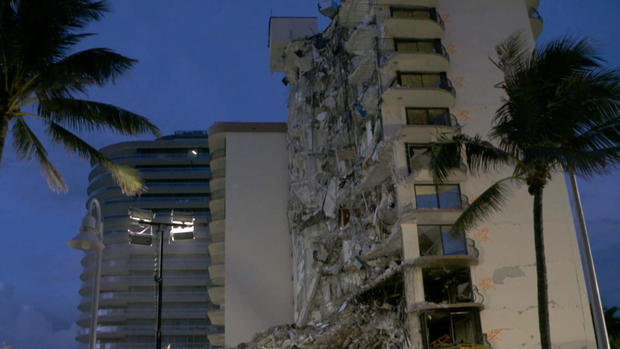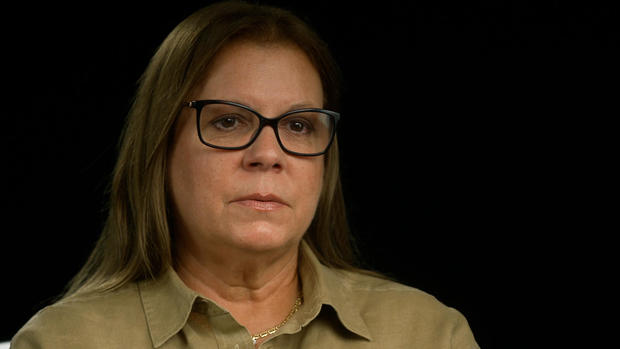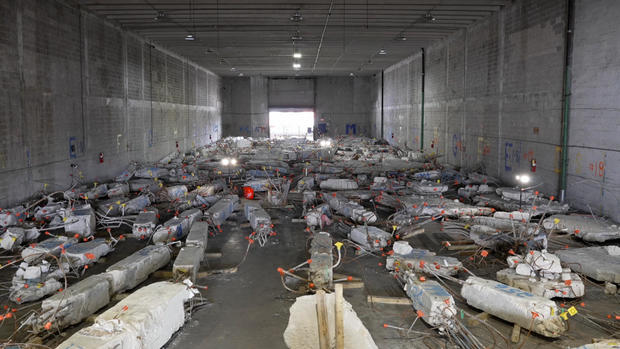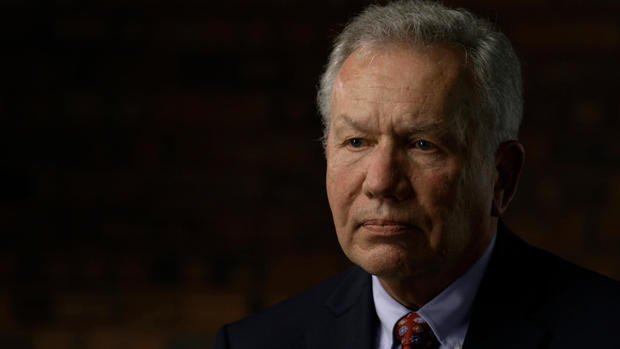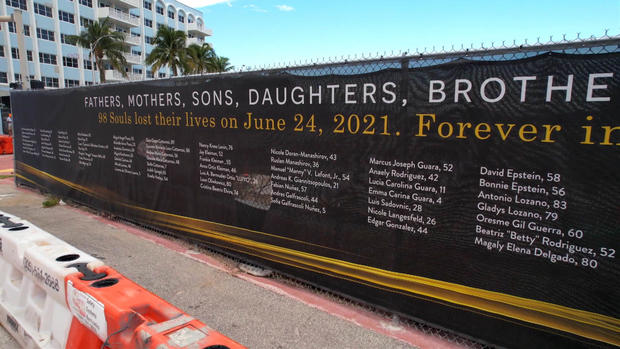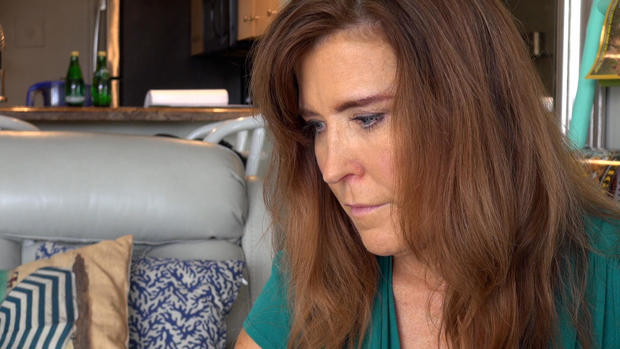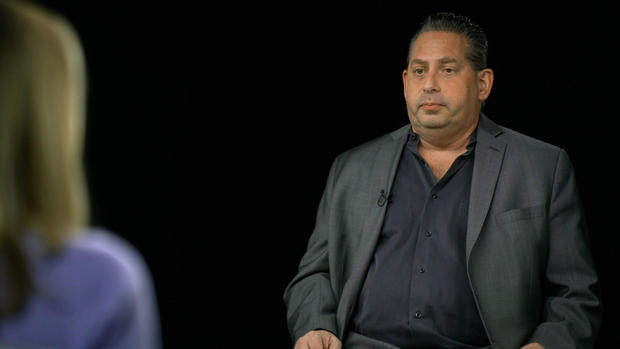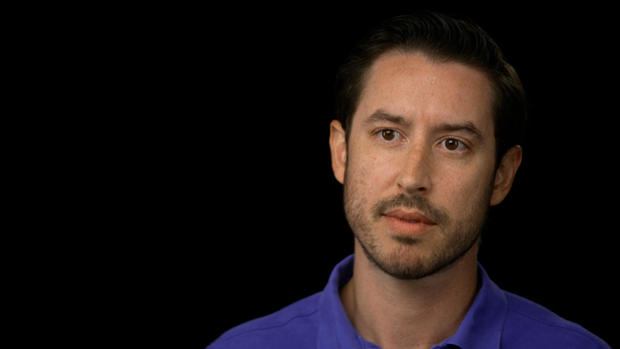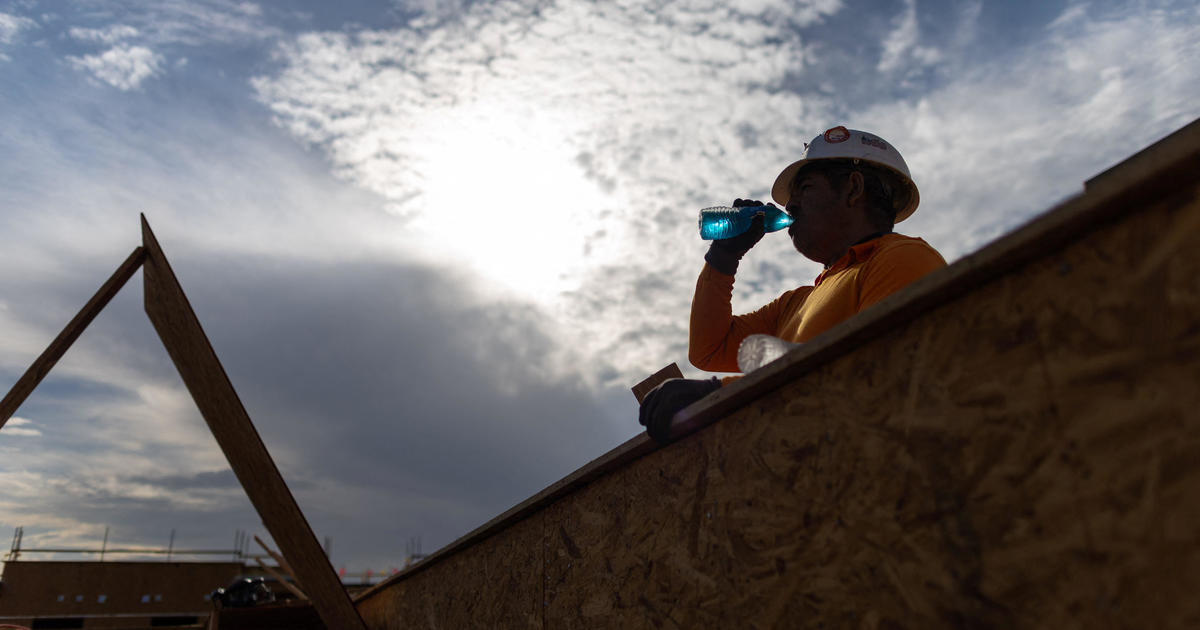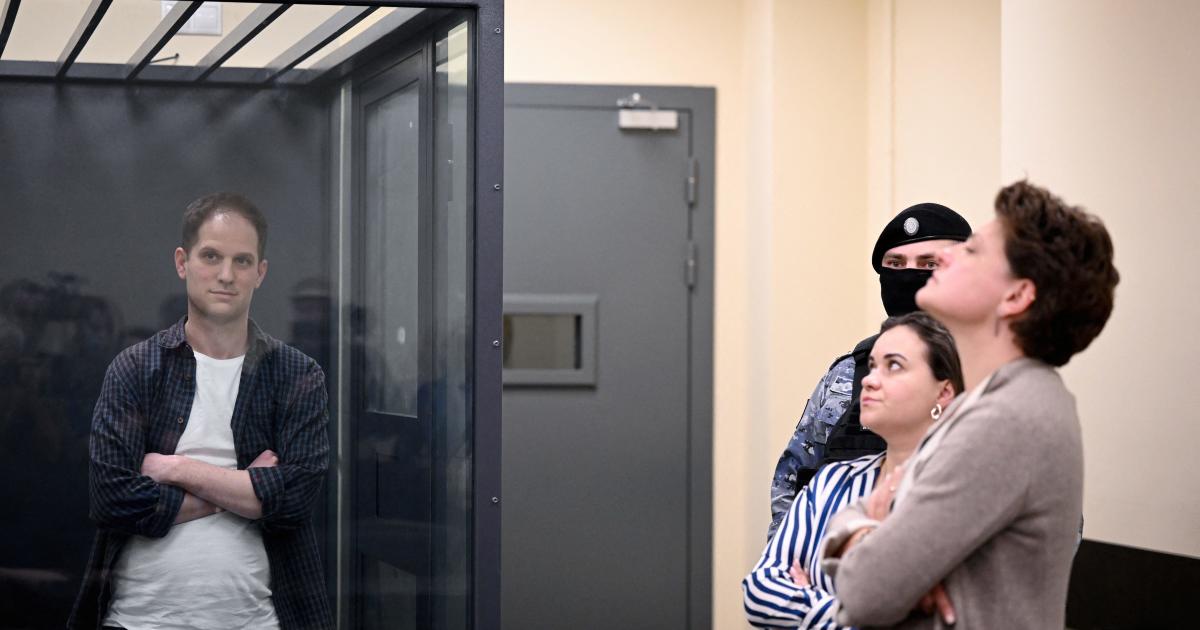Surfside condominium collapse: Still searching for answers in the rubble
This past week, Hurricane Nicole, a Category 1 storm, forced residents in more than a dozen condominiums near Daytona Beach from their homes because officials declared the buildings unsafe. In September, Hurricane Ian caused more than $40 billion in damage across Florida. To cover the bill, it's widely expected insurance premiums are going to go up in the Sunshine State. Another disaster was already threatening to make housing unaffordable for many. Last year, Champlain Towers South, a 40-year-old condominium in the city of Surfside, collapsed in the middle of the night. Ninety-eight people were killed. More than a year later, no one knows why the building fell. We wondered why it was taking so long to find an answer. Tonight, you'll hear from the engineers leading the local and federal investigations and see how the Surfside mystery is impacting Florida condo owners.
The collapse can be seen in surveillance video from a nearby building. Just beyond the pool, the middle of the condo collapses, disappearing into dust. Seconds, later, the oceanside wing seems to melt to the ground. It was about 1:30 in the morning.
Raysa Rodriguez: I am sound asleep and I hear this awful noise and I didn't know what it was it felt like a mountain coming down. And two seconds later, all I remember is literally being thrown out of my bed and landing in front of the bed.
Raysa Rodriguez lived on the 9th floor in the part of the building that somehow remained standing.
Raysa Rodriguez: and there was a small balcony. So I stepped out and my brain just couldn't compute what I was looking at. I said to myself, "where's the building?" You know, screaming at this time, "where's the building?"
The elevators were gone. The stairwells clogged with concrete.
Sharyn Alfonsi: And there's no way for you to get out of the building at this point?
Raysa Rodriguez: There's no way for me to get out and I think I just snapped into, "Okay, this is the situation. I'm terrified. I don't wanna die tonight..."
So Rodriquez, started navigating a way down. Helping an elderly neighbor through dark hallways and over the debris in stairwells.
It took more than two hours before they reached a floor low enough to be rescued with a ladder.
Today, this is all that is left of the building, a concrete scar in the ground. The names of the victims are listed on a fence that surrounds the site. It includes retirees and young families.
Raysa Rodriguez: People went to sleep that night. In the safest spot in-- their world is your home. Your bedroom it wasn't the safest spot in the world.
Sharyn Alfonsi: What answers do you want?
Raysa Rodriguez: What answers I want? I want the truth for my friends who died. They deserve an answer.
The answer could be in this massive Miami warehouse where the remnants of Champlain Towers, 800 tons of it, are being stored.
The facility is off limits to anyone except federal investigators, who provided us with video. They have started combing through the twisted steel and concrete for clues.
Glenn Bell is one of the team's lead investigators. Bell spoke to us from the headquarters of the National Institute of Standards and Technology, the agency conducting the federal investigation.
Sharyn Alfonsi: When do you think we will know why the building collapsed?
Glenn Bell: So our timeline for this investigation was to finish our technical findings by the fall of 2023. Then we have to work on our report and recommendations. And we're looking for that the fall of 2024.
Sharyn Alfonsi: A lot of people in Florida can't understand why this is taking as long as it is.
Glenn Bell: I want them to know that we're working as fast as we can. And the implications for our findings are huge. We have to get this right.
Based on what's found, Bell's team will recommend any necessary changes to building codes or construction methods nationwide.
Glenn Bell: We have-- over 600 pieces of the structure that we're gonna be doing a lot of testing on. And the more that you put together, the more the pieces of the puzzle begin to emerge and stories-- emerge.
Sharyn Alfonsi: What is the story that's emerged at this point? What do you know?
Glenn Bell: Right now we're pursuing about two dozen hypotheses about what the causes may have been.
Among the possibilities are shoddy construction, bad design or faulty materials. Bell was on the engineering team that investigated the collapse of the World Trade Center following the 9/11 attack and came out of retirement to try and solve the Surfside mystery.
Glenn Bell: I've been investigating failures for over 40 years. And this particular investigation I can say is one of the most complex and challenging that has ever been undertaken.
Sharyn Alfonsi: Why is that?
Glenn Bell: Sometimes in building failures, the immediate causes are relatively apparent. We have no such apparent cause in Champlain Towers after well more than a year.
Investigators started scanning pieces of the debris into a massive 3D database last spring. Preliminary lab tests on building materials began in August. Glenn Bell told us if investigators discover anything that poses a danger to other buildings, they will reveal it immediately.
Sharyn Alfonsi: Is it possible after the investigation's complete that you won't know what caused the building to collapse?
Glenn Bell: I'm confident that we will. But it will take a long time.
Back in Surfside, Allyn Kilshiemer told us the investigation doesn't need to take two more years. He was hired by the City of Surfside hours after the collapse to conduct its own investigation.
Allyn Kilshiemer: We have to get to the trigger. I always say a building talks to you if you know how to listen to it alright. And it finds a way to support itself or it finally says, "I give up. I can't support it. I'll fall down."
Kilsheimer, a renowned engineer, was part of the investigation after the Oklahoma City bombing and the 9/11 attack on the Pentagon.
Sharyn Alfonsi: So where are you in the investigation right now? How far along?
Allyn Kilshiemer: We're about eight months behind of where I wanted to be…
That's because Kilsheimer is still negotiating with the federal investigators for permission to do his own tests on the building samples locked up in that warehouse.
Sharyn Alfonsi: Is this unusual?
Allyn Kilshiemer: I've never run into it before.
Sharyn Alfonsi: Not with the Pentagon? Not with the Oklahoma City bombing?
Allyn Kilshiemer: I've never run into it before. It's very unusual.
It took until this past August before Allyn Kilsheimer was allowed to do this, his first big on-site test.
We watched as his team used 350 tons of steel plates to measure how much load the structural pilings at the site could handle.
Allyn Kilshiemer: This building sat there for a very long time. Right? It's been there for forty years It's full of people for 40 years. It has cars in it for 40 years. Buildings just don't fall down.
With neither Kilsheimer or federal investigators providing answers, survivors and victim's families have come up with their own hypotheses. One – is that weeks of vibrations from construction of that oval-shaped condo next door somehow compromised Champlain Towers South. A 2019 email from a resident to the city complained the digging was, "…too close to our property and we have concerns regarding the structure of our building."
Sharyn Alfonsi: Some of the people who lived in the towers-- have expressed a lotta concern about vibrations of the building that was next to it being built. Is that something that you're looking into?
Glenn Bell: These are just one or two of the many failure hypotheses that we're pursuing. But we definitely are looking at it very carefully.
The companies that built that condo were among the participants in a $1.1 billion settlement with survivors and victims' families. The insurers for the project paid $400 million, but said the development had no role in the collapse. The deal is no comfort to Shannon Gallagher. She lives in a condo thats next door to new construction in surfside.
Sharyn Alfonsi: This building's how old?
Shannon Gallagher: 1965.
Sharyn Alfonsi: 1965. How safe do you feel in it?
Shannon Gallagher: I don't. I don't.
Gallagher is worried about the potential of vibrations from work planned just below her and has asked a Florida court to intervene.
Shannon Gallagher: So you see this little two-story building? This building is gonna be replaced with a building that's actually gonna be significantly taller. It's gonna be about 158 feet. You can literally feel vibrations when they were working on that building and it's a further lot away. And you could-- you could be standing and feel the building vibrate.
Sharyn Alfonsi: I can hear people who live in Manhattan say, "We build right next to each other. What's the problem?"
Shannon Gallagher: I understand development. But there's gotta be some thought for who you're building next to.
Families of the victims have also accused the condo board at Champlain Towers South of not immediately repairing major structural damage. In a 2018 report, an engineer hired by the condo board flagged failed waterproofing below the pool deck and cracking in columns in the garage.
Eric Glazer: They needed $15 million to make the repair to the garage and the-- the structure. They had $700,000.
Eric Glazer has practiced condo law in Florida for 30 years and estimates he's trained 22,000 owners across the state in how to manage their condos.
Eric Glazer: In order to get on the board, there's no prior qualifications that you're an accountant, or you're an attorney, or you have any prior business experience whatsoever.
Sharyn Alfonsi: So what happens?
Eric Glazer: Sometimes the budget isn't done right. Sometimes the spending isn't done right. Oftentimes the repairs are not done right.
And Glazer told us condo boards can face intense pressure from neighbors – especially retirees – to keep costs low. That's not easy. Two-thirds of the condos in Florida are at least 30 years old. In October, a 50-year-old condo in Miami Beach was deemed unsafe and its residents ordered out when engineers found a crack in a main support beam had expanded.
Eric Glazer: Doesn't anybody think eventually these buildings are gonna need repair?
Sharyn Alfonsi: And now the bill's come due.
Eric Glazer: And now the bill's come due.
The scrutiny of condo boards pushed Florida's legislature to pass sweeping condo laws.
The new requirements include structural inspections by engineers or architects for condos three stories or higher. Any recommended fixes must be made and condo boards will have to set aside enough money for future repairs.
Eric Glazer: Now you are having situations in Florida where people on a fixed income are going be asked to come up with thousands of dollars and they don't have it.
Sharyn Alfonsi: How will this change who comes to Florida, who lives in Florida?
Eric Glazer: Well, the days of grandma and grandpa, who are s-- solely on social security, coming to Florida and thinking that they're gonna move into a condominium, that's gone forever.
Glazer expects the developers. who have already transformed much of South Florida's coast into a canyon of glass and steel, will look to buy out older condos that can't afford repair. Then, tear them down and replace them with a more profitable luxury condominium.
Robert Lisman: Less than a year after Champlain Towers collapsed we had a development firm come and make offers. What we were offered was significantly below market value.
Robert Lisman and his family live two doors down from the collapse in a condo built by the same developers as Champlain Towers South.
Sharyn Alfonsi: Do you think they thought, "These people are desperate, they're scared, and they're gonna take these offers?"
Robert Lisman: Absolutely. They could buy our apartment for what it's worth, they could buy our building for what it's worth and still make a killing off of it.
Sharyn Alfonsi: Are you worried that another developer's gonna come and say, "Hey, you know, most of you aren't gonna be able to afford this. Can I buy your apartment?"
Robert Lisman: I know that there's gonna be a lot of owners that are gonna look at that amount, and then look at this offer that they're given, and-- and go for whatever it is that they can get.
As part of the settlement with homeowners, Raysa Rodriquez told us she got less than market value for the condo she lost.
$70 million was paid to lawyers who represented survivors and victims' families.
As for the property where Champlain Towers South once stood? It's been sold for $120 million to a developer from the Persian Gulf, with plans to build a luxury condominium.
Produced by Guy Campanile. Associate producer, Lucy Hatcher. Broadcast associate, Elizabeth Germino. Edited by Joe Schanzer.
